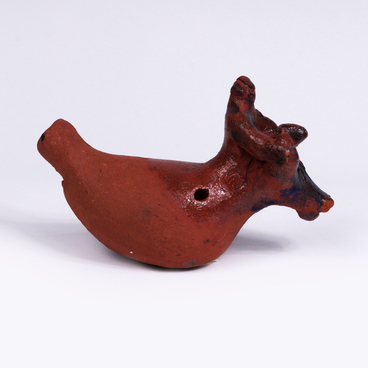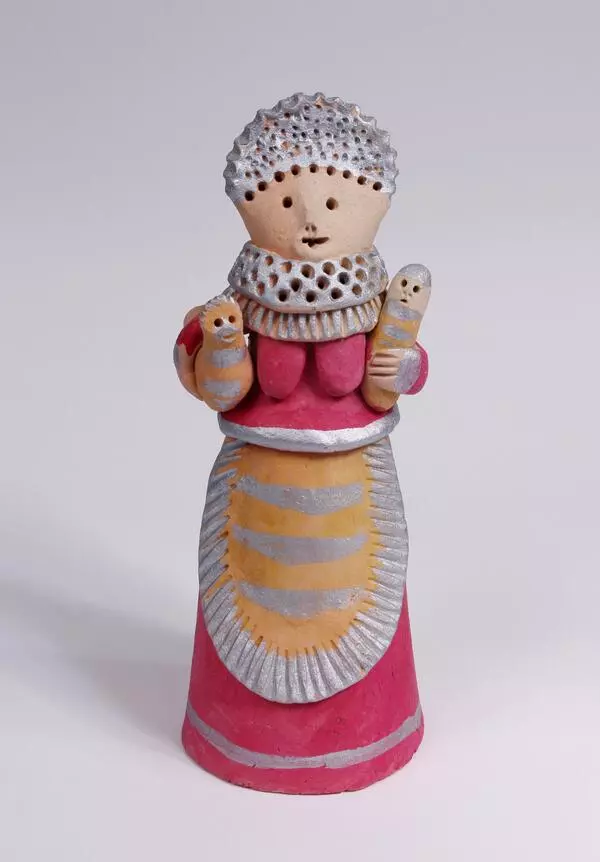The ‘Sirin’ figurine, made by Viktor Markin, is the Romanovo clay toy. Usually, the Romanovo toys are whistles with multiple playing holes. They are distinguished by a round shape and are decorated with notches. People loved these whistles for their simple design and the sense of ease they radiated. This whistle has a rather large cavity, so it produces a buzzing sound.
In this figurine of Sirin (a mythological creature of Russian legends, symbolizing eternal joy and heavenly happiness), the craftsman combined the images of a woman from the Romanovo village and the bird of paradise. This plot echoes the ancient Greek myth of Sirens — half birds, half women. The mythical Sirens charmed people with their singing. According to legend, they lived on an island and lured nearby sailors with their incredibly beautiful voices. If the ship’s crew heard their singing, they would turn the ship, wreck it on the rocky coast and die. But in Slavic mythology, this character has a completely different meaning: only happy people could see the wonderful bird Sirin and hear its beautiful singing.
Apart from the paradise bird, Viktor Markin also created many other different images — roosters with a half-sun crest, ducks with ducklings, dancing bears, horsemen. Bird-shaped whistles are traditionally molded in large sizes and lushly decorated with a glued-on decoration, a high semi-sun crest. A figurine of Bereginya (a female character of East Slavic mythology) is dressed up in a red jacket, a bright skirt, multi-colored ribbons, and beads.
The Romanov toy got its name from the village of the same name, located near Lipetsk. Romanovo originated in the 16th century when the Romanov boyars formed a settlement for their peasants. The village was later divided into parts. The part from where the Romanovo toy is originated received the new name — Troitskoye. According to folk tradition, the Troitsk figurines of animals are made sideways but the figurines of people — full-face. The toy is covered with enamel or color diluted with the egg.
Nowadays, the Troitskoye village houses the Center of the Romanovo Toy. It was founded by Victor Markin in 1986, and it is the only such center in the whole region. The artisan learned the craft from the hereditary potter Ivan Gunkin. Unfortunately, Gunkin died in 1997, but he left a rich legacy: several of his images became classics of the Romanovo toy. Viktor Markin introduced new plots into the craft as well, including Sirin.
In this figurine of Sirin (a mythological creature of Russian legends, symbolizing eternal joy and heavenly happiness), the craftsman combined the images of a woman from the Romanovo village and the bird of paradise. This plot echoes the ancient Greek myth of Sirens — half birds, half women. The mythical Sirens charmed people with their singing. According to legend, they lived on an island and lured nearby sailors with their incredibly beautiful voices. If the ship’s crew heard their singing, they would turn the ship, wreck it on the rocky coast and die. But in Slavic mythology, this character has a completely different meaning: only happy people could see the wonderful bird Sirin and hear its beautiful singing.
Apart from the paradise bird, Viktor Markin also created many other different images — roosters with a half-sun crest, ducks with ducklings, dancing bears, horsemen. Bird-shaped whistles are traditionally molded in large sizes and lushly decorated with a glued-on decoration, a high semi-sun crest. A figurine of Bereginya (a female character of East Slavic mythology) is dressed up in a red jacket, a bright skirt, multi-colored ribbons, and beads.
The Romanov toy got its name from the village of the same name, located near Lipetsk. Romanovo originated in the 16th century when the Romanov boyars formed a settlement for their peasants. The village was later divided into parts. The part from where the Romanovo toy is originated received the new name — Troitskoye. According to folk tradition, the Troitsk figurines of animals are made sideways but the figurines of people — full-face. The toy is covered with enamel or color diluted with the egg.
Nowadays, the Troitskoye village houses the Center of the Romanovo Toy. It was founded by Victor Markin in 1986, and it is the only such center in the whole region. The artisan learned the craft from the hereditary potter Ivan Gunkin. Unfortunately, Gunkin died in 1997, but he left a rich legacy: several of his images became classics of the Romanovo toy. Viktor Markin introduced new plots into the craft as well, including Sirin.


